You may save hundreds of dollars by planting your own hanging baskets for your porch, patio, and outdoor landscape.
Homemade hanging baskets offer color and charm throughout the farm. They illuminate decks, patios, sitting spaces, pergolas, pavilions, and other outdoor constructions.
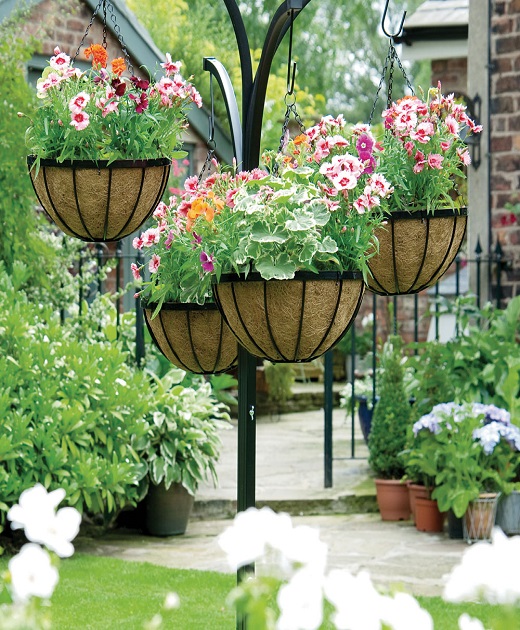
But can they be quite expensive? Depending on the size of the basket, hanging baskets can cost anywhere from twenty to thirty dollars to more than a hundred dollars or more.
But, perhaps more frustratingly, many store-bought baskets outgrow their pots and soil by mid-summer. It’s not only upsetting, but it can add to the cost if you have to replace them.
The Problem With Store Bought Hanging Baskets
When you buy a container or basket from a store in early spring, it’s likely that the plants within have been growing for months.
This is done by greenhouses and farmers in order to produce large, eye-catching flowers that can be displayed to attract new clients. The main issue is that the roots of the basket are frequently already out of room. That implies your basket time is almost due.
The good news is that you no longer have to suffer from “hanging basket” irritation. In the spring, you may build beautiful planters that are overflowing with color and endure the entire season by planting your own baskets and paying attention to a few basic but important tips.
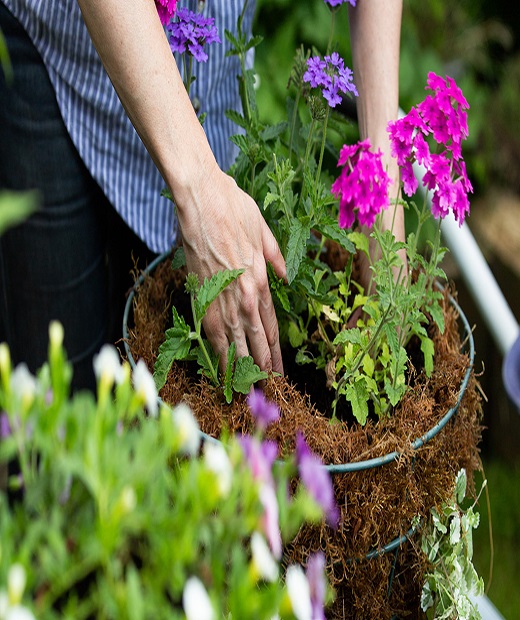
If you’re looking to grow your own hanging baskets this year, we’ve got some tips for you!
An Easy Guide To Growing Your Own Hanging Baskets
Start With Bigger Baskets
As time has passed, we’ve come to realize that long-term success hinges heavily on the size of the basket in question. Smaller baskets may be less expensive, but they don’t provide enough room for plants to develop. Especially if you want them to endure the entire season!
The more soil you can use, the better your plants will do. It’s that simple. By the middle of summer, roots have run out of room in smaller baskets. As a result, the roots of the plants become tangled.
It is nearly impossible to offer a plant lasting water or nutrients once it has become root bound. It drains out of the bottom as you water it. And what about the fertilizer you may be using? It does the very same thing.
There will be no more flowers and no more healthy leaves on your root bound basket unless you replant it. A plant having an unappetizing appearance at the end of the day.
What Size Basket Is Best?
Using a basket less than 14 inches in diameter is a waste of time and money. When they’re first planted, 10 and 12-inch pots look beautiful, but they quickly overrun their space.
Although 14-inch baskets work, we prefer the 16-inch metal wire baskets. They have a diameter of 16 inches, which provides plenty of room for expansion. Even better, they’re still manageable to lift and hang even at that size.
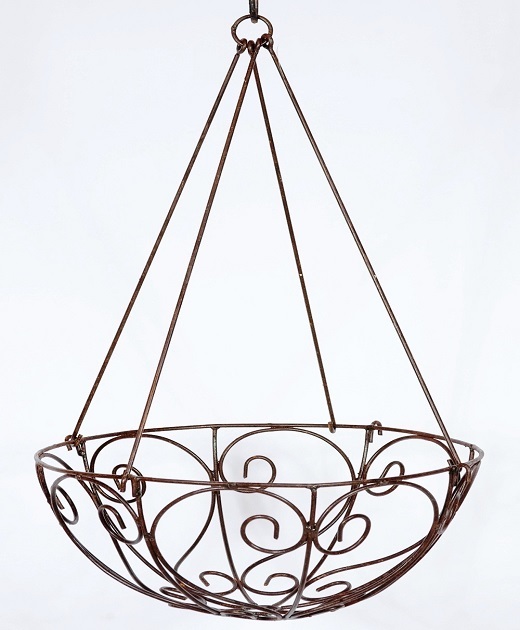
Whatever the case may be, the real secret to success is to stick with baskets that are 14 inches or larger. It gives plants the space they need to thrive throughout the season.
Plastic Baskets vs. Wire Baskets
Wire baskets are preferable to plastic containers. And it’s not just for aesthetics.
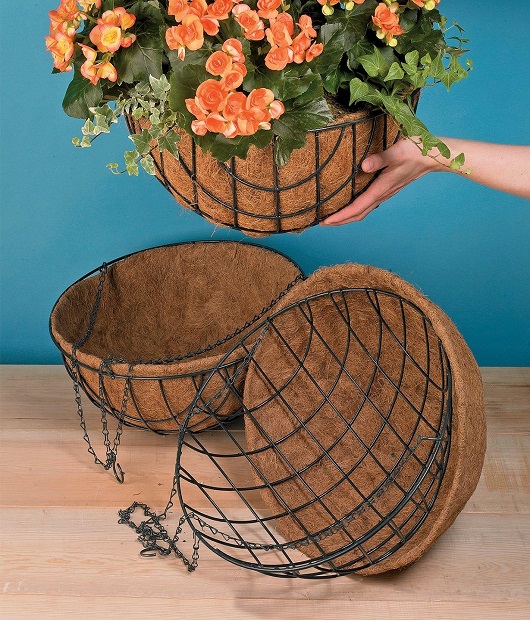
Plants have a number of problems when they’re housed in plastic containers. For starters, the plastic wrap that surrounds the entire root ball acts as a heat sink. And in the midst of summer, excessive heat can have a negative impact on plants. The non-porous, complete covering also makes it more difficult for oxygen to reach the roots.
Air can easily enter wire baskets with a fibrous coco coir lining or an all-natural weave liner. Unlike plastic containers, these containers allow water to drain off considerably more quickly. Plus, natural liners are inexpensive and simple to switch out year after year.
Although wire baskets are more expensive initially, they have the advantage of lasting for many years. A plastic basket’s lifespan is often limited to one season. The first season of a show isn’t always even enough for them.
Choosing The Best Soil For Hanging Baskets
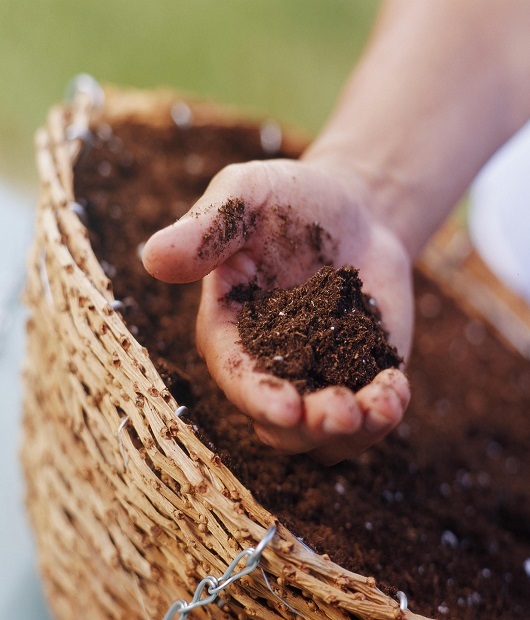
Filling your basket with quality soil is the next step once you have your basket ready to go. Potting soil is the one item you should never compromise on.
Make your own or buy ready-made potting soil, but make sure it’s rich, loose, and full of nutrients. For container plants, it’s crucial to start them off with a high-quality mix of soil because they will spend the entire year in the same place.
Selecting the Right Plants for Hanging Baskets
It’s important to start with species that produce big bloom sets without too much foliage when trying to figure out what plants function best in hanging baskets of any kind. When it comes to “WOW” factor, flowers always beat over foliage.
Calibrachoa (Million Bells), Wave petunias, begonias, impatiens, lantana, and verbena are all good annuals for hanging baskets. They all have stunning flower sets that can endure the entire growing season in full bloom if properly cared for.
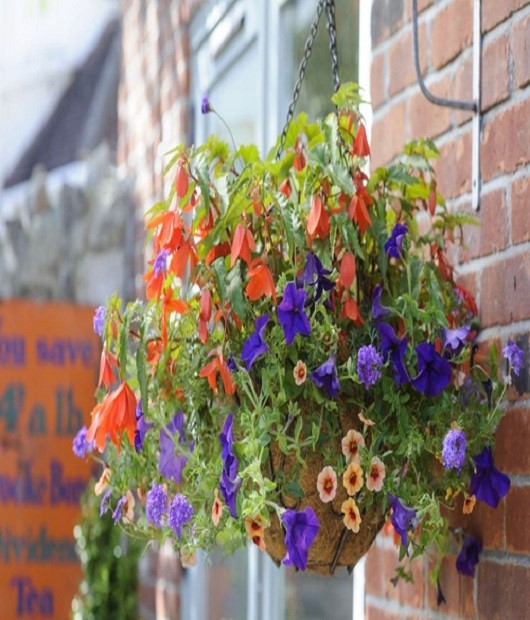
Choosing the standards is an important step, but it is not the only one. You may also think outside the box when it comes to making DIY baskets. You can try using ornamental peppers in your handcrafted hanging baskets.
Its thick, dark foliage contrasts beautifully with the hundreds of brightly colored pepper “blooms.” It’s a good idea to plant ornamental peppers in the summer because they are incredibly drought and heat tolerant.
Our preferred ornamental peppers to use in baskets are chili-chili and Sangria. You can’t go wrong with either of these beauties when it comes to color.
How Many Plants Should You Plant?
How many plants you put in each basket is just as crucial as what you choose to grow. When it comes to hanging baskets and other containers, it’s easy to get carried away with adding too many stuff. Unfortunately, your baskets will quickly suffer as a result.
Certainly, the problem of over-planting is understandable. We, of course, want the flowers to fill the area and look stunning from the very first day of their presence..
When you plant too much in one area, you don’t leave room for future growth. Overcrowding occurs quickly as a plant grows. In a small area, there is a limited supply of both water and nutrients, thus they compete.
Planting for the long haul is the key to success. You can for example use seven annual plants in your 16-inch baskets, and place 5 on each side of the centre, and then two in the center. For 14-inch baskets, you can use a spacing of 5 to 6 in the same manner.
For the first several weeks, it may appear sparse, but they have plenty of area to grow. Sowing your seeds in this manner insures a full growing season of flowering.
How to Fertilize Your Hanging Baskets for Success
To keep your hanging baskets blooming all season, even if you start with the best soil possible, you’ll need to add additional fertilizers. There is no doubt that they will fail if they don’t get further aid sooner rather than later.
When it comes to fertilizing hanging baskets, going slow and steady is the key to success. Fertilizing in modest amounts on a regular basis is critical. This keeps plants strong without enabling them to grow out of control.
When it comes to fertilizing your baskets, you can take a two-pronged strategy. To begin, you sprinkle a cup of worm castings on top of each basket once a month. This is a fertilizer that releases slowly. The nutrients in the castings are washed down to the soil below every time you water.
You may also want to fertilize your baskets with a light liquid fertilizer every two weeks, in addition to the castings on top of the plants. For this feeding, you can use compost tea, worm casting tea, or even an excellent all-purpose liquid fertilizer.
Feed sparingly!
The idea is to keep the feeding light on. Compost or worm casting tea can be used in hanging baskets because the energy is already regulated. If you’re using a commercial liquid fertilizer, you may generally get away with using only 1/4 to 1/2 the recommended strength.
By giving your plants a smaller quantity every two weeks, you can maintain them vigorous and blossoming without overfeeding them. In addition to outdoor plants, this feeding strategy is equally effective for container plants.
How to Water Hanging Baskets
Finally, watering is just as important to a plant’s short and long-term success as the soil, plants, and fertilizer schedule you utilize.
Hanging plants dry out far more quickly than those on a bed. Because they’re in the air, they have no way to keep their moisture from condensing. As a result, most hanging baskets require daily watering. As a matter of fact, certain plants may necessitate twice-daily watering.
Early in the morning is the ideal time to water your hanging baskets. It provides plants with the moisture they need to survive the sweltering conditions of the day. The best time to go is in the early evening.
Unfortunately, watering plants in the middle of the day can lead to problems. Because of the sun’s rays hitting water droplets, plants’ foliage and flowers might be damaged. If you must water in the middle of the day, do so from the base of the plants rather than directly on the leaves.
Happy hanging basket gardening, and good luck with your flowers this year.

